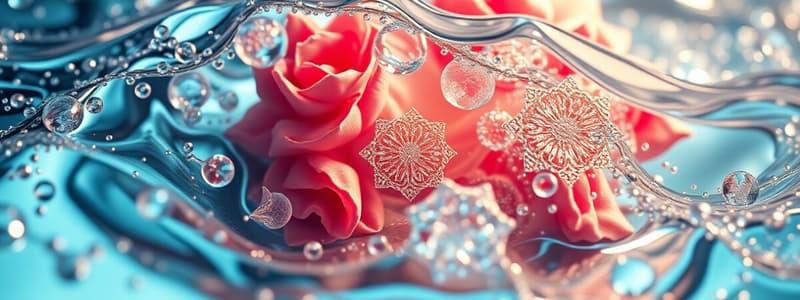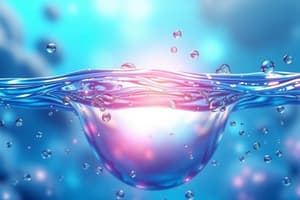Podcast
Questions and Answers
What is the main reason water is considered a universal solvent?
What is the main reason water is considered a universal solvent?
- It has a high density that facilitates dissolving.
- It can dissolve all types of substances.
- It can form hydrogen bonds with many polar molecules. (correct)
- It contains both hydrogen and oxygen atoms.
Which of the following correctly differentiates between monomers and polymers?
Which of the following correctly differentiates between monomers and polymers?
- Monomers combine to form polymers through hydrolysis.
- Monomers are larger molecules, while polymers are smaller.
- Monomers do not have any distinct chemical structure.
- Polymers are made up of many monomers connected by covalent bonds. (correct)
What is the significance of buffer systems in biological systems?
What is the significance of buffer systems in biological systems?
- They only increase acidity levels.
- They are unnecessary for cellular functions.
- They solely provide nutrients for cellular processes.
- They prevent extreme changes in pH, maintaining homeostasis. (correct)
Which statement about the amino acid structure is accurate?
Which statement about the amino acid structure is accurate?
What characterizes the four levels of protein folding?
What characterizes the four levels of protein folding?
How does dehydration synthesis contribute to the formation of carbohydrates?
How does dehydration synthesis contribute to the formation of carbohydrates?
What is a key difference between DNA and RNA?
What is a key difference between DNA and RNA?
What role does carbon's valence play in biological molecules?
What role does carbon's valence play in biological molecules?
Flashcards are hidden until you start studying
Study Notes
Water
- Polarity: Water is a polar molecule due to the uneven sharing of electrons between the oxygen and hydrogen atoms.
- Hydrogen bonding: The partial positive charge on the hydrogen atom of one water molecule attracts the partial negative charge on the oxygen atom of another water molecule, resulting in a hydrogen bond.
- Cohesion: Water molecules stick to each other due to hydrogen bonding. This is why water forms droplets.
- Adhesion: Water molecules stick to other polar substances, such as glass. This is why water wets surfaces.
- Capillary action: The combination of cohesion and adhesion allows water to move up narrow tubes, like the xylem in plants.
- Surface tension: Water molecules at the surface exhibit stronger cohesive forces than the water molecules below, resulting in surface tension. This is why insects can walk on water.
- Universal solvent: Water is a good solvent because it can dissolve many polar and ionic substances due to its polarity.
- Density: Water is less dense as a solid (ice) than as a liquid. This is why ice floats.
- High heat capacity: Water can absorb a lot of heat energy without a significant change in temperature. This helps to regulate body temperature in organisms.
- High heat of vaporization: Water requires a lot of heat energy to change from a liquid to a gas. This is why sweating helps to cool us down.
- Buffers: Buffers are solutions that resist changes in pH. They are important for maintaining a stable internal environment in living organisms.
- pH: pH is a measure of the acidity or alkalinity of a solution. pH values range from 0 to 14, with 7 being neutral, below 7 being acidic, and above 7 being alkaline.
Carbohydrates
- Monomers and Polymers: Monomers are small, repeating units that make up larger molecules called polymers.
- Carbohydrate Monomers: The monomer of carbohydrates is a monosaccharide, such as glucose, fructose, and galactose.
- Carbohydrate Polymers: Polymers of carbohydrates are called polysaccharides. Examples include starch, glycogen, and cellulose.
- Macromolecule Composition: Carbohydrates are made up of the elements carbon (C), hydrogen (H), and oxygen (O).
- Hydrogen Bonds and Covalent Bonds: Carbohydrates are held together by covalent bonds within the molecule and hydrogen bonds between molecules.
Proteins
- Importance of Carbon Valence: Carbon has four valence electrons, allowing it to bond with up to four other atoms, forming complex molecules like proteins.
- Amino Acid Structure: An amino acid consists of a central carbon atom bonded to an amino group (-NH2), a carboxyl group (-COOH), a hydrogen atom (-H), and a variable side chain (R group).
- Protein Polymerization: Proteins are polymers made up of amino acid monomers.
- Dehydration Synthesis and Peptide Bonds: The formation of a peptide bond between two amino acids involves the removal of a water molecule through a process called dehydration synthesis.
- Protein Hydrolysis: The breakdown of a protein into its constituent amino acids occurs through the addition of a water molecule, called hydrolysis.
- Enzyme Function: Enzymes are proteins that catalyze (speed up) biochemical reactions. They are essential for all biological processes.
- Protein Folding: The specific three-dimensional structure of a protein is crucial for its function. The folding process is influenced by interactions between amino acid side chains.
- Levels of Protein Folding:
- Primary Structure: The linear sequence of amino acids.
- Secondary Structure: Local folding patterns, such as alpha helices and beta sheets.
- Tertiary Structure: The overall three-dimensional shape of a single polypeptide chain.
- Quaternary Structure: The arrangement of multiple polypeptide chains (subunits) in a protein.
Nucleic Acids
- DNA and RNA: DNA (Deoxyribonucleic Acid) and RNA (Ribonucleic Acid) are nucleic acids that store and transmit genetic information.
- Central Dogma: The central dogma of molecular biology describes the flow of genetic information from DNA to RNA to protein.
- Nucleotide Structure: A nucleotide is composed of a sugar molecule, a phosphate group, and a nitrogenous base.
- DNA Bases: Adenine (A), guanine (G), cytosine (C), and thymine (T).
- RNA Bases: Adenine (A), guanine (G), cytosine (C), and uracil (U).
- Nucleic Acid Polymerization: Nucleic acids are polymers made up of nucleotide monomers.
- Dehydration Synthesis and Phosphodiester Bonds: The formation of a phosphodiester bond between two nucleotides involves the removal of a water molecule through a process called dehydration synthesis.
Studying That Suits You
Use AI to generate personalized quizzes and flashcards to suit your learning preferences.




